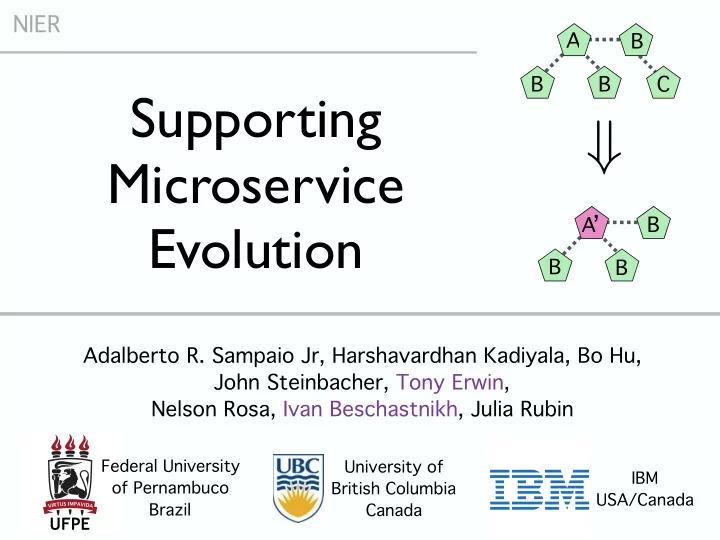

NIER A B B B C Supporting ⇒ Microservice A ’ B Evolution B B Adalberto R. Sampaio Jr, Harshavardhan Kadiyala, Bo Hu, John Steinbacher, Tony Erwin, Nelson Rosa, Ivan Beschastnikh, Julia Rubin Federal University University of IBM of Pernambuco British Columbia USA/Canada Brazil Canada UFPE
From monoliths to microservices App Microservices-based App ( App) µ • Microservices ( ) µ Services • Fast and easy to deploy • Can be scaled independently • Multilingual and multi-technology • Loose dependencies (REST) … https://martinfowler.com/articles/microservices.html Supporting microservice evolution 2
From monoliths to microservices App µ App • Microservices ( ) µ Services • Fast and easy to deploy Constant ⇒ evolution • Can be scaled independently • Multilingual and multi-technology • Loose dependencies (REST) Supporting microservice evolution 3
Evolution-related challenges A B C • Upgrades break inter-services compatibility • Different teams work on different services • Tracking down failure root causes complicated • Many moving parts that keep changing • Deployment configuration must also evolve • Changes to performance/dependencies impact config Supporting microservice evolution 4
Existing tool support • Academia: app-bisect [1], GRU [2], Gremlin [3], Formal methods [4] • OpenSource (Industry): Istio [5] (IBM/Google), Zipkin [6] (Twitter), Kubernetes [7] (Google), ELK stack [8] Wanted: program analysis to support change [1] Rajagopalan and Jamjoom, App–Bisect: Autonomous Healing for Microservice-Based Aps , HotCloud 2015 [2] Florio et al., Gru : an Approach to Introduce Decentralized Autonomic Behavior in Microservices Architectures , ICAC 2016 [3] Heorhiadi et al., Gremlin: Systematic Resilience Testing of Microservices , ICDCS 2016 [4] Panda et al., Verification in the Age of Microservices, HotOS 2017 [5] https://istio.io/ [6] http://zipkin.io/ [7] https://kubernetes.io/ [8] https://logz.io/learn/complete-guide-elk-stack/ Supporting microservice evolution 5
Existing tool support • Academia: app-bisect [1], GRU [2] • OpenSource (Industry): Istio [3] (IBM/Google), Zipkin [4] (Twitter), Kubernetes [5] (Google), ELK stack [6], Zuul [7] (Netflix), InfluxDB [8] µ App Idea: model over time Wanted: program analysis to support change [1] Rajagopalan and Jamjoom, App–Bisect: Autonomous Healing for Microservice-Based Aps , HotCloud 2015 [2] Florio et al., Gru : an Approach to Introduce Decentralized Autonomic Behavior in Microservices Architectures , ICAC 2016 [3] https://istio.io/ [4] http://zipkin.io/ [5] https://kubernetes.io/ [6] https://logz.io/learn/complete-guide-elk-stack/ [7] https://github.com/Netflix/zuul/ [8] https://www.influxdata.com/ Supporting microservice evolution 6
µ App Model over time LOG LOG Continuous Model Log Analysis LOG LOG LOG µ App Model Changes Analysis Developer App 1. Construct a model of the and its configuration µ 2. Update model as or configuration change App µ 3. Analyze sequence of models (past, present, future) 4. Use the analysis to support developers Supporting microservice evolution 7
Proposed evolutionary (meta) model * * Scenario Operation Message {ordered} «enumeration» * +correlationId: String Environment +timestamp: long * * * Application ApplicationVersion CONTAINER +totalTime: long VIRTUAL_MACHINE +processingTime: long PHYSICAL_MACHINE * * * * Metric OperationVersion Provider Service +source +cpu: float +isExternal: boolean +memory: float * * * +API +target * Location Host ServiceVersion * * ServiceReplica +hosting: Environment * * Architectural Layer Infrastructure Layer Instance Layer Supporting microservice evolution 8
Example model instance EastCoast WestCoast Application ToDo ApplicationVersion Provider ApplicationVersion version 1 IBM Bluemix version 2 Host Location Location Host vm1 EastCoast WestCoast vm2 ServiceReplica ServiceReplica Frontend.1.A Frontend.2.A ServiceReplica Frontend.2.B ServiceVersion frontend.1 ServiceVersion frontend.2 Service Frontend Supporting microservice evolution 9
Model analysis Retrospective Prospective Analysis Analysis Future … Curr. Prev Init Model 1 Model Model Model Future Now Model2 … Time • Sequence of models over time allows for rich analyses • Retrospective: Study inter-services messages to recommend service refactorings • Prospective: Explore and instantiate new deployment configurations to optimize resources usage Supporting microservice evolution 10
Ongoing/future work • Assessing developer needs: which tasks are the most pressing? • Model representation: many modeling formalisms, which one is the best for the task? • Defining analysis: Build on existing model analysis work • Extensibility: Can we allow the model to change? (Cannot foresee future information we may need to integrate) • Social factors: interplay between technical and social dependencies Image from: https://martinfowler.com/bliki/MicroservicePrerequisites.html Supporting microservice evolution 11
Microservices require new approaches A B • Loose coupling B B C • Rapid deployment Constant ⇒ • Multi-lingual Change A ’ • Multiple teams B B B Vision: Generate an evolutionary model from dynamic observations (logs) for retrospective and prospective analyses Find us at tomorrow’s poster session! https://github.com/adalrsjr1/k8s-monitoring 12
Recommend
More recommend